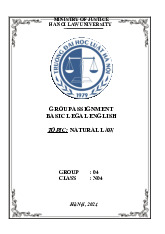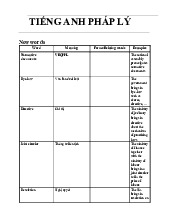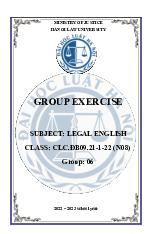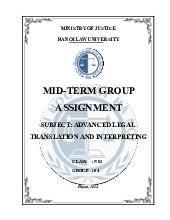













Preview text:
MINISTRY OF JUSTICE HANOI LAW UNIVERSITY GROUP ASSIGNMENT Lecturer : Class
: 482 5 Group
: 0 5
Subject : Legal English 3
TEAMWORK ASSESSMENT REPORT Team: 05 Group members: 04 Class: 4825
Topic: Comparison of the legal profession structure in Vietnam and the UK Student Name Revie Sign Lecturer’s reviews id w A B C A B C 1 482513 Nguyễn Chí Cường X 2
482515 Nguyễn Văn Đức Dũng X 3 482516 Dương Mạnh Đức X 4 482520 Trần Minh Hải X
Assignment degree: Hanoi, ………….April , 2025
First lecturer: Team leader Second lecturer: Presentiation degree Final degree INDEX
INTRODUCTION...................................................................................................1
BODY........................................................................................................................2
I. Prolonged delays and backlogs...........................................................................2
1.1 Introduction to the issue................................................................................2
1.2 Official timeline vs reality..............................................................................2
1.3 Key causes of delays and backlogs ....................................................................6
1.4 Impact on larger disputes and the system ........................................................7
II. Difficulty Enforcing Court Judgments ..................................................................7
III. Underutilised Mediation in Civil Cases..........................................................6
3.1. Introduction & Definition: ......................................................................................9
3.2. Legal framework for mediation in Vietnam ...................................................9
3.3 Reasons for underutilisation and recommendations...................................7
CONCLUSION......................................................................................................10
REFERENCES......................................................................................................12 INTRODUCTION
Civil procedure is the body of law that governs the process for resolving
disputes between private parties, like individuals or businesses, in court, covering
issues such as contracts or property disputes, distinct from criminal cases. It
includes steps like filing complaints, serving documents, conducting trials, and
enforcing judgments, varying across jurisdictions (e.g., U.S. common law or
France’s civil law), but always aiming for a fair, structured process. Civil procedure
ensures justice by providing predictability, fairness, due process, and enforceable
rulings, preventing chaos in dispute resolution. This presentation examines
structural issues in Vietnam’s civil procedure framework, such as delays,
enforcement challenges, access to justice, and procedural inefficiencies, which
impact significant disputes. It offers insights and reform recommendations, drawing
on international comparisons, to strengthen Vietnam’s legal system, supporting its
economic growth and global integration, while educating stakeholders like
policymakers and legal practitioners on needed improvements. BODY
I. Prolonged delays and backlogs
1.1 Introduction to the issue * Definition -
Prolonged Delays: Extended periods in case processing beyond what isprescribed by law. -
Court Backlogs: Many cases are pending resolution in the judicial system. * Context
- According to the 2015 Civil Proceedings Code, a first instance
mattershould conclude within 8 months. However, due to the complexity, appeals or
extraordinary reviews can prolong the timeline of a civil proceedings case to 12-18 months.
1.2 Official timeline vs reality * Official Standards:
- “Under the 2015 Civil Procedure Code, a normal first-instance civil
caseshould conclude in about eight months (Article 203). The court must notify the
claimant within 2 working days, assign a judge within 3 days, and that judge has 5
days to accept or return the claim (Article 191). Once accepted, the court typically
has 4 months (or 2 for certain disputes) to prepare for trial—plus brief extensions if
the case is complex—and must open the hearing within 1 month (or 2 if justified),
ensuring timely resolution absent appeals.”1* Real-World Observations:
- “If the first-instance judgment is appealed or protested under Article
273,the process can easily extend to 12–18 months. Under Article 286, the appellate
court has 2 months (extendable by 1 month) to prepare for trial, then must open the 1
https://economica.vn/Content/files/LAW%20%26%20REG/92_2015_QH13%20Civil%20Procedure
%20Code.pdf(Accessed: 17 April 2025).
hearing within 1 or 2 months, thereby prolonging proceedings. If cassation (giám
đốc thẩm, Article 331) or retrial (tái thẩm, Article 355) is invoked, the total
timeframe can stretch to 2–3 years or more.”2
1.3 Key causes of delays and backlogs
- Each year, the Vietnamese Court handles more than 400,000 civil and
commercial cases. The huge caseload and administrative delays lead to procedural
inefficiencies, and it can take years to pursue a case. In 2022 alone, Vietnamese
courts handled approximately 444,402 civil cases and resolved 386,944, leaving
over 57,000 unresolved, highlighting the scale of backlog that such complex cases
can amplify. Civil disputes in Vietnam often go through multiple rounds of review,
including first-instance trials, appeals, cassation, and even retrial procedures. Larger
cases tend to be especially complex, involving voluminous evidence, numerous
parties, and detailed contractual relationships, all of which prolong resolution.
Vietnam’s judiciary faces ongoing resource constraints, including a limited number
of judges and court staff across its multi-level court system. Although digital
reforms are underway, such as virtual assistant software and plans for e-courts—the
lack of a comprehensive case management system continues to slow down
processing times and contribute to backlogs. These structural challenges hinder the
timely resolution of civil disputes, especially as caseloads grow.3 4 5 2
https://economica.vn/Content/files/LAW%20%26%20REG/92_2015_QH13%20Civil%20Procedure
%20Code.pdf(Accessed: 17 April 2025).
3 https://law.asia/vietnam-dispute-resolution-challenges/ (Accessed: 17 April 2025)
4 https://www.researchgate.net/publication/380142808_The_System_of_The_Trial_Agencies_that_Resolve
_Civil_Cases_in_Vietnam_Currently(Accessed: 17 April 2025). 5
https://www.researchgate.net/publication/384994146_Digital_transformation_and_building_ecourts_to_me
et_the_requirements_of_judicial_reform_in_Vietnam (Accessed: 17 April 2025).
1.4 Impact on larger disputes and the system
- Prolonged civil case resolutions in Vietnam not only create uncertainty but
also generate measurable pressure on the legal system. For businesses and investors,
the rising number of disputes reflects growing concerns about efficiency, evidenced
by the Vietnam International Arbitration Centre (VIAC) handling 424 cases in 2023,
a 46.2% increase from the previous year . Such trends suggest that⁴ more investors
are turning to arbitration as confidence in court efficiency declines. For individuals,
these delays can mean long waits for decisions that impact their lives, such as
unpaid debts, property division, or family disputes, causing emotional strain and
financial difficulty. From a systemic perspective, the persistent backlog of
unresolved cases continues to erode public trust and place additional strain on
already limited judicial resources.6
II. Difficulty Enforcing Court Judgments
One of the most common difficulties in civil judgment enforcement is
Difficulties in dividing and Handling Joint Assets, for example:
Article 74 of the Law on Civil Judgment Enforcement only provides general
rules for dividing a debtor’s assets within shared property, without specifying how
to divide the joint assets of spouses. To clarify this, Clause 2, Point c, Article 24 of
Decree No. 62/2015/ND-CP provides more detailed guidance: "The enforcement
officer determines each spouse's share according to marriage and family law and
informs both spouses. If one spouse disagrees, they can ask the Court to divide the
property within 30 days of receiving the notification. If no one files a claim, the
enforcement officer will seize the property and return the value of the share to each spouse."
6 https://www.viac.vn/en/statistics/statistics-on-dispute-resolution-activities-in-2023-s43.html (Accessed: 17 April 2025).
Although the law gives enforcement officers and the Court the right to divide
joint assets, practical issues arise:
-For the Enforcement Officer: In practice, when dividing joint assets,
sometimes the officer does not divide the assets directly but tells the spouses to file
a lawsuit in Court. If no one files, the officer will file a claim asking the Court to
divide the property. The division must follow marriage and family laws, but rules
regarding joint and separate property, especially real estate, are complex. This can
lead to problems in verifying the origin of assets, making the division less fair or
accurate. For this reason, the Court's decision is more reliable.
-In Practice: Judgment debtors and co-owners of the joint property usually do
not want to file a lawsuit because they do not want their assets seized. Also, if no
claim is made within 30 days, the enforcement officer must seize the property and
return the value of the share to the rightful owners. This can negatively affect those
not involved in the judgment, leading to additional costs like asset valuation and
auctioning, with potential risks for the enforcement officer.
In addition, there are also difficulties regarding the verification of
enforcement conditions: According to the provisions in Article 44 of the Civil
Judgment Enforcement Law and Clause 1, Article 9 of Decree No. 62/2015/ND-CP
of the Government, it is stipulated: "When conducting the verification, the
enforcement officer requires the person subject to enforcement to truthfully declare
and provide complete information about assets, income, enforcement conditions,
etc. The enforcement officer must specify whether the party declares or fails to
declare assets, income, and enforcement conditions." In practice, the enforcement
process faces several challenges and obstacles, such as: It is necessary, in all cases,
for the enforcement officer to meet with the person subject to enforcement in order
to establish a verification record; waiting for the truthful declaration and provision
of complete information about assets, income, and enforcement conditions from the
person subject to enforcement is often a formal requirement. In practice, this is
rarely carried out, as the person subject to enforcement often does not cooperate
with the enforcement officer and evades responsibility.7
III. Underutilised Mediation in Civil Cases
3.1. Introduction & Definition:
Mediation is a voluntary, confidential, and flexible dispute resolution process
in which a neutral third party assists conflicting parties in reaching a mutually
acceptable solution. In civil litigation, it applies to a broad range of cases, including
contract disputes, torts, property issues, and family law matters. Cases like this
function better on the cooperative side rather than the adversarial side. Even though
mediation offers clear benefits, savings on time and cost, reduction of court
backlog, preservation of relations, it has not been utilized far and wide in the civil
justice system of Vietnam. Some reasons behind that underutilization include a
mixture of cultural shyness, limitations imposed on mediation at the institutional
level, and practical considerations. The rest of the discussion will look at the
obstacles related to mediation and will also deliberate on legal frameworks that support mediation in Vietnam.
3.2. Legal framework for mediation in Vietnam
In response to growing concerns over judicial inefficiencies and the
increasing demand for alternative dispute resolution, Vietnam has progressively
reformed its legal framework to foster a mediation-friendly environment.
- The Civil Procedure Code (amended 2015): encourages judges to
facilitatesettlements and mediation before trial.
- The Law on Mediation and Dialogue at Court (2020) introduces a
formallegal framework for court-connected mediation.
7 https://thads.moj.gov.vn/noidung/tintuc/lists/nghiencuutraodoi/view_detail.aspx?itemid=920 (Accessed: 17 April 2025).
- Decree No. 22/2017/ND-CP: provides specific guidelines for out-of- courtcommercial mediation.
Overall, these legal instruments reflect a significant commitment by the
Vietnamese government to integrate mediation into the judicial process. By
establishing both formal and informal mechanisms, Vietnam not only aims to
alleviate caseload pressures on its courts but also seeks to cultivate a dispute
resolution culture that is more collaborative and accessible to all citizens.
3.3 Reasons for underutilisation and recommendations
Reasons for Underutilisation of Mediation in Civil Cases Limited
Awareness and Understanding
Many litigants and legal professionals in Vietnam are unaware of mediation’s
advantages—such as reduced costs, quicker outcomes, and a less adversarial
process—and often do not know how to initiate it. Legal professionals often remain
unaware of mediation’s benefits because traditional legal education emphasises
adversarial litigation and fosters a practice culture that values lengthy court
processes over quicker, cost-effective resolutions, especially when fee structures
reward prolonged litigation. This gap is compounded by limited continuing
education and insufficient exposure to successful mediation outcomes. For example,
in a commercial parties might bypass mediation due to insufficient advice from their
legal counsel, leading to protracted litigation. The lack of targeted public awareness
and limited emphasis in legal education further reinforces a bias toward traditional court proceedings.
Limited Lawyer Motivation to Promote Mediation
The current financial structure in civil cases typically rewards lawyers for
lengthy litigation, which generates higher fees compared to quick settlements
through mediation. For instance, in a property dispute, the legal teams preferred
court battles over mediated resolutions due to the potential for greater revenue, as
proven by the cases in reality. This economic dynamic, coupled with limited
professional recognition for mediation efforts, discourages many lawyers from
recommending or pursuing alternative dispute resolution methods.
Unclear or Weak Enforcement of Mediated Agreements
Although Vietnamese law allows mediated agreements to be recognised by
the courts, doubts linger about their practical enforceability. Nonetheless, the formal
recognition does not always translate into effective enforcement in practice.
For example, a commercial settlement reached through mediation was significantly
delayed in enforcement, prompting stakeholders to question its reliability when
compared to formal court judgments. The perceived complexity of converting a
mediation outcome into an enforceable court order further undermines confidence in the process. Additional Factors
In addition to the core challenges, several supplementary factors further
impede the widespread acceptance of mediation in civil cases
- Insufficient training for mediators: This results in a lack of advanced
skillsneeded to handle complex disputes, ultimately undermining confidence in the mediation process
- Prevailing cultural preference for adversarial litigation has long
beeningrained in Vietnam's legal community, where traditional courtroom battles
are seen as the norm, leaving little room for alternative, cooperative methods.
Compounding these issues is the absence of widely publicised success stories
in mediation; without high-profile examples of effective outcomes, stakeholders
have limited evidence to support the reliability of mediation, which further
discourages its use as a trusted dispute resolution approach. CONCLUSION
Vietnam's civil procedure system faces significant inefficiencies, and ongoing
reforms aim to modernise the system, enhance dispute resolution, and align it with
the country’s socio-economic development and international integration. One
prominent reform proposal is the integration of information technology into civil
proceedings, such as expanding online trials, electronic filing, and adopting Online
Dispute Resolution (ODR) platforms. While technology promises to reduce time
and costs and improve access to justice, Vietnam’s infrastructure remains a
challenge, with issues like digital illiteracy and connectivity problems. The success
of these reforms will depend on substantial investments in infrastructure and digital literacy programs.
Another key proposal is promoting mediation and alternative dispute
resolution (ADR), which could reduce court backlogs, expedite dispute resolution,
and save costs. However, Vietnam’s legal culture is not yet familiar with mediation,
making its implementation challenging. Public awareness and specialised training
for mediators are essential for effective deployment. There is also concern that
making mediation mandatory before litigation could undermine its voluntary nature,
which is crucial to its effectiveness.
Streamlining civil procedure by simplifying processes for straightforward
cases is another proposed reform. While this could speed up case resolution, it must
be balanced carefully to avoid compromising justice, especially in more complex
cases where reducing procedural steps could lead to overlooked evidence or rights violations.
Enhancing the capacity of judicial personnel is also critical. Proposals
emphasise training judges and legal professionals in technology, electronic evidence
collection, and trial management. With the rise of e-commerce disputes, the ability
of the judiciary to handle modern challenges effectively requires such training.
Finally, there is a push to strengthen adversarial proceedings in court, giving
litigants more control and reducing the judge's inquisitorial role. However, critics
argue that a shift to a fully adversarial system might overwhelm the judicial system
and disadvantage those without adequate legal resources.
These reform proposals have sparked ongoing debates. Should Vietnam adopt
a fully adversarial system, or retain its hybrid model? While technological
integration is viewed as essential for modernisation, critics point out infrastructure
gaps and privacy risks. Regarding mediation, there is a debate about whether it
should be mandatory before litigation, with concerns that this might reduce its
voluntary nature. Additionally, streamlining procedures presents the challenge of
balancing efficiency with thoroughness, as hasty decisions in complex cases could undermine justice.
In conclusion, the reforms proposed for Vietnam's civil procedure—ranging
from technology integration and mediation to streamlined processes, judicial
training, and strengthening adversarial proceedings—reflect a commitment to
modernisation. However, these changes require careful planning, balancing
efficiency with fairness, and investing in infrastructure and education. Only with
careful implementation can these reforms succeed in making Vietnam’s civil
procedure system more efficient and accessible.
The systemic challenges within Vietnam’s civil procedure - namely,
prolonged delays, ineffective enforcement mechanisms, and underutilised mediation
- highlight fundamental limitations in both institutional capacity and procedural
design. These issues are not isolated; rather, they interact and reinforce one another,
contributing to inefficiency, legal uncertainty, and declining public confidence in the
judiciary. When civil disputes cannot be resolved within reasonable timeframes,
judgments remain unenforced, and viable alternatives like mediation are
overlooked, the credibility of the entire legal system is placed at risk. Addressing
these structural deficiencies is not simply a matter of legal reform, but a necessary
step toward safeguarding access to justice, enhancing judicial accountability, and
maintaining the legitimacy of the rule of law in Vietnam. REFERENCES
1. “Civil Procedure Code of Vietnam (No. 92/2015/QH13)”, National Assembly
ofVietnam, https://economica.vn/Content/files/LAW
%20%26%20REG/92_2015_QH13%20Civil%20Procedure%20Code.pdf
2. “Key challenges to dispute resolution in Vietnam”, Written by Vu Dzung Tien
and Nguyen Thanh Minh, https://law.asia/vietnam-dispute- resolutionchallenges/
3. “The system of the trial agencies that resolve civil cases in Vietnam
currently”, Written by Nguyen ThiThanhHien,
https://www.thelawyerportal.com/careers/difference-between-solicitor- andbarrister/
4. “Digital transformation and building e-courts to meet the requirements of
judicial reform in Vietnam”, Written by Nguyen Thi Thanh Hien,
https://www.researchgate.net/publication/384994146_Digital_transformation _and_building_e-
courts_to_meet_the_requirements_of_judicial_reform_in_Vietnam
5. “Statistics on dispute resolution activities in 2023”, Vietnam International
Arbitration Centre (VIAC), https://www.viac.vn/en/statistics/statistics-
ondispute-resolution-activities-in-2023-s43.html
6. “Some issues on enforcement of civil judgments and decisions related to
credit and banking in Vietnam”, Ministry of Justice Vietnam,
https://thads.moj.gov.vn/noidung/tintuc/lists/nghiencuutraodoi/view_detail.as px?itemid=920




